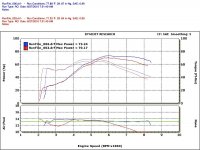Below is a run @100% (only) throttle dyno run for a custom mapped Norge in Sweden (read he is *not* running AutoTune, nor my ECU). Keep in mind, this is only at 100% throttle, which most people rarely spend any time at. Also note the horrifically rich stock fueling at 5.5k+ RPMs as shown by the red line dipping downwards below 10.0:1 AFR  , and the PC-V corrected blue line.
, and the PC-V corrected blue line.
Thanks to Tommy for sending me the drf files(!).
Thanks to Tommy for sending me the drf files(!).



